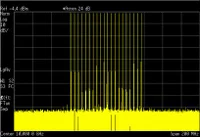Keysight Signal Studio software is a flexible suite of signal-creation tools that will reduce the time you spend on signal simulation. For component and system verification, Signal Studio’s performance-optimized reference signals—validated by Keysight—enhance the characterization and verification of your devices. Through its application-specific user-interface you’ll create standards-based and custom test signals for component, transmitter, and receiver test.
Signal Studio’s enhanced multitone capabilities use waveform playback mode to create and customize waveform files needed to test components and transmitters. Its user-friendly interface lets you configure signal parameters, calculate the resulting waveforms and download files for playback.
Signal Studio’s NPR option enables the creation of a large number of tones to simulate Gaussian Noise with a notch in it. The individual tone properties are not directly accessible by the user. The NPR application provides methods to define the noise signal including the noise bandwidth (number of ones and tone spacing), the phase type (random, parabolic, and constant) and the notch width and offset from the noise center. The NPR interface also allows the user to specify the IMD correction level desired within the notch (in-band corrections).
Key Features:
- Create Keysight validated and performance optimized multitone and noise power ratio (NPR) signals for testing narrowband components and receivers for communications systems
- Configure distortion-free two-tone and multitone test signals, with up to 4097 tones (IMD suppression > 70 dBc)
- Configure an NPR test stimulus with more than 2 GHz noise BW, notch depth > 60 dBc, and ± 0.5 dB noise flatness
- Control magnitude and phase (random, parabolic, or constant phase) for individual tones with presets across tones to control CCDF characteristics
- Automate signal configuration and generation using the COM and .NET API and sequence waveforms with API for smooth transition between signals
- Accelerate the signal creation process with a user interface based on parameterized and graphical signal configuration and tree-style navigation







